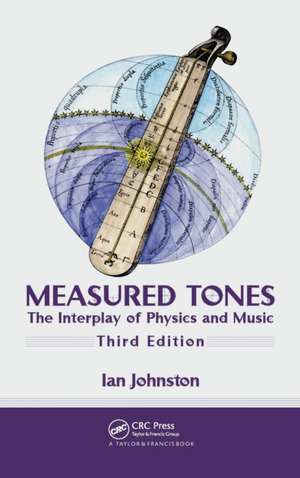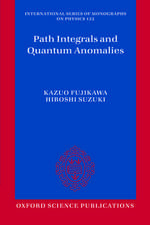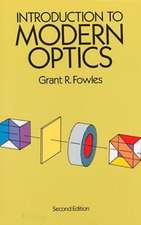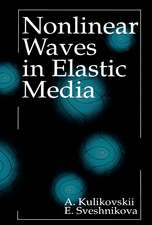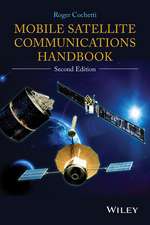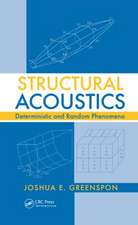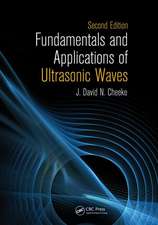Measured Tones: The Interplay of Physics and Music, Third Edition
Autor Ian Johnstonen Limba Engleză Hardback – iun 2009
- Features a greater examination of psycho-acoustics and its role in the design of MP3s
- Includes expanded information on the gamelan and other Asian percussion instruments
- Introduces detailed discussions of binary notation, digitization, and electronic manipulation of music
With myriad illustrations and historical anecdotes, this volume will delight those student required to approach this topic from either a physics and music concentration, as well as anyone who is fascinated with concepts of harmony expressed in nature, as well as in the instruments and composition of human expression’s purest form.
A complementary website provides sound files, further reading, and instructional support.
Preț: 579.75 lei
Preț vechi: 682.06 lei
-15% Nou
Puncte Express: 870
Preț estimativ în valută:
110.94€ • 116.12$ • 92.33£
110.94€ • 116.12$ • 92.33£
Carte tipărită la comandă
Livrare economică 31 martie-14 aprilie
Preluare comenzi: 021 569.72.76
Specificații
ISBN-13: 9781420093476
ISBN-10: 1420093479
Pagini: 454
Ilustrații: 384 b/w images
Dimensiuni: 156 x 234 x 28 mm
Greutate: 0.77 kg
Ediția:Revizuită
Editura: CRC Press
Colecția CRC Press
ISBN-10: 1420093479
Pagini: 454
Ilustrații: 384 b/w images
Dimensiuni: 156 x 234 x 28 mm
Greutate: 0.77 kg
Ediția:Revizuită
Editura: CRC Press
Colecția CRC Press
Public țintă
UndergraduateCuprins
Why These and Not Others? Length of strings. Harmonious Intervals. Pythagoras. Pentatonic and Pythagorean Scales. Ptolemy. Boethius. Music and Scientific Method. Medieval Music. Josquin. Copernicus. Kepler. Galileo. Vibrations. Pendulums and Strings. Consonance. Measurement of Frequency. Standards of Pitch. Interlude 1. Brass Instruments. Harmonies of a Mechanical Universe. Mechanical Forces. Energy. Oscillation Theory. Mersenne’s Laws. Baroque Music. Instruments. Equal Temperament. Interlude 2. The Piano. Overtones of Enlightenment. Newton and the Age of Reason. Visualization of Oscillations. Overtones. Harmonic Analysis and Synthesis. Rameau and Harmony. End of the Enlightenment. Interlude 3. The Violin. Over the Waves. Wave Theory. Speed of Sound. Wave Properties: Reflection, Absorption, Diffraction. Huygens and Young. Standing Waves. Interlude 4. Acoustics in Architecture. The Romance of Electricity. The Romantic Movement. Study of Electricity, Faraday. Acoustics. Energy Coupling and Acoustic Impedance. Mismatch Theorem. Standing Waves in Air Columns. Interlude 5. Woodwind Instruments. Summertime in Heidelberg. Wagner and Helmholtz. Theory of Resonance. Working of the Ear. Pitch Recognition and Discrimination. Psycho-Acoustics. Theory of Consonance. Interlude 6. Percussion Instruments. O brave New World. Communication Devices: Microphones, Gramophones, Valves, Transistors. Effect on Music. Modern Sound Engineering: Frequency Response, Transients. Technology. Interlude 7. Electronic Instruments. I think, Therefore I am. Theory of Communication. Information. Computers. Computer Composition. Interlude 8. Sublimest of Instruments, the Voice.
Notă biografică
Ian Johnston spent his early years on a pineapple farm in southern Queensland, studied physics and mathematics at the Universities of Queensland and Sydney, and was appointed to a lecturing position at the University of Sydney in the late 1960s. He has been there ever since until he retired in 2001, except for two separate years in the U.S. at Cornell and Maryland Universities and one year in England at the Open University.
His early research work was in theoretical astrophysics, but lately he has become interested in research into physics education, with particular emphasis on the role to be played by computers and other forms of information technology. He has written a deal of educational software as a member of several international consortiums, most notably the Maryland University Project in Physics and Educational Technology (M.U.P.P.E.T.) and the Consortium for Upper-Level Physics Software (CUPS). His interest in acoustics and music has been with him all his working life.
In 1989 he made a series of six programs on Australian national radio, devoted to physics and music. It was from those programs that the idea of this book first arose. He has also made programs on other subjects of general interest, including astronomy and religion, science fiction and pseudo-science.
His early research work was in theoretical astrophysics, but lately he has become interested in research into physics education, with particular emphasis on the role to be played by computers and other forms of information technology. He has written a deal of educational software as a member of several international consortiums, most notably the Maryland University Project in Physics and Educational Technology (M.U.P.P.E.T.) and the Consortium for Upper-Level Physics Software (CUPS). His interest in acoustics and music has been with him all his working life.
In 1989 he made a series of six programs on Australian national radio, devoted to physics and music. It was from those programs that the idea of this book first arose. He has also made programs on other subjects of general interest, including astronomy and religion, science fiction and pseudo-science.
Recenzii
… If you have ever wondered why we use the notes we do, why instruments sound different and why they are constructed as they are, look no further: Measured Tones will answer many, if not all, of your questions. Ian Johnston has managed to appeal to a physicist with an interest in music, to a musician with an interest in physics or even a general reader who is merely interested. The subtitle is particularly apt as the book takes a more or less historical path to consider the interplay of physics and mathematics with the music of the period. … I devoured the book from cover to cover and thought overall that it was a wonderful read. It is exactly the sort of book that I hope someone would buy me as a present (if I did not already have a copy). It is now a treasured part of my personal library.
—Contemporary Physics, Volume 51, Issue 6, 2010
Praise for the Second Edition
The writing throughout is delightfully clear and easy to read, and the numerous small illustrations break up the pages and add interest … . Students (and teachers!) not having had the benefit of such a course should certainly buy the book and read it. I also recommend it warmly to the general reader who would simply like to know more about the sounds he or she enjoys.
—Neville Fletcher, Acoustics Australia
Johnston offers a charming, informal, and information-packed volume aimed squarely both at the musician who wants to understand better some of the physics behind the sound that various instruments make and at the physicist who would like to understand better the workings of musical instruments… . Lots of material is covered, and the book is worthy of careful examination… . It belongs in all college libraries.
—K.L. Schick, CHOICE
I find it unputdownable, combining a thorough development of the mathematical and physical basis of music, dealt with in a historical framework, with interludes dealing in details with the different families of musical instruments. This new edition has updated the sections on electronic music and digital technology, which have changed vastly in the last decide, and which feature prominently in the new AS/A2 specifications. Thoroughly recommended.
— John Miller, School Science Review
It is an ideal book for a secondary school library … it also makes a useful supplementary text for the undergraduate module in musical instrument acoustics that we run at the ISVR … . A particular strength is the detailed discussion of the development of musical scales and temperaments, a subject that is so often glossed over.
—M.C.M. Wright, Journal of Sound and Vibration
—Contemporary Physics, Volume 51, Issue 6, 2010
Praise for the Second Edition
The writing throughout is delightfully clear and easy to read, and the numerous small illustrations break up the pages and add interest … . Students (and teachers!) not having had the benefit of such a course should certainly buy the book and read it. I also recommend it warmly to the general reader who would simply like to know more about the sounds he or she enjoys.
—Neville Fletcher, Acoustics Australia
Johnston offers a charming, informal, and information-packed volume aimed squarely both at the musician who wants to understand better some of the physics behind the sound that various instruments make and at the physicist who would like to understand better the workings of musical instruments… . Lots of material is covered, and the book is worthy of careful examination… . It belongs in all college libraries.
—K.L. Schick, CHOICE
I find it unputdownable, combining a thorough development of the mathematical and physical basis of music, dealt with in a historical framework, with interludes dealing in details with the different families of musical instruments. This new edition has updated the sections on electronic music and digital technology, which have changed vastly in the last decide, and which feature prominently in the new AS/A2 specifications. Thoroughly recommended.
— John Miller, School Science Review
It is an ideal book for a secondary school library … it also makes a useful supplementary text for the undergraduate module in musical instrument acoustics that we run at the ISVR … . A particular strength is the detailed discussion of the development of musical scales and temperaments, a subject that is so often glossed over.
—M.C.M. Wright, Journal of Sound and Vibration
Descriere
Ian Johnston offers an informal historical approach that shows the evolution of both theory and application at the intersection of physics and music. Exceptionally accessible, insightful, and now updated to consider modern technology, the new edition of this critically acclaimed bestseller features a greater examination of psycho-acoustics and its role in the design of MP3s. It also includes expanded information on the gamelan and other Asian percussion instruments, and discusses binary notation, digitization, and electronic manipulation of music. A complementary website provides sound files, further reading, and instructional support.
